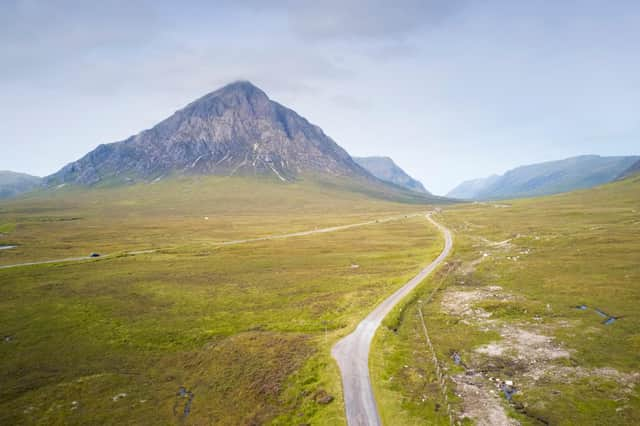The West Highland Way at 40: a conservation project that's also an economic development strategy


Not long after the end of the Second World War, a keen hillwalker called Tom Hunter, recently returned from RAF service in Algiers, Italy, Yugoslavia and Germany, stood on the western slopes of Ben Lomond with his wife Margaret and soaked up the view. As he gazed across Loch Lomond to an area on the other side of the water that had been earmarked for development, he wondered if there was any way of preventing similar things from happening on the eastern side of the loch. “There’s enough walking country for our lifetime,” he said, “but if we don’t do something now there will be none for future generations.”
When Tom and Margaret returned home to Glasgow, they discussed their concerns with some of their hillwalking friends, and before long Tom was busy making plans for a long-distance walking route that would run from Milngavie to Fort William, a total distance of 96 miles. After the geographer Fiona Rose surveyed the route over a year in the early 1970s, covering some 1,000 miles on foot, Hunter’s brainchild, the West Highland Way, was officially approved for development in 1974 and opened by Lord Mansfield on 6 October 1980, the first officially designated long-distance footpath in Scotland.
Advertisement
Hide AdAdvertisement
Hide AdMuch will be made of the route’s 40th anniversary next week, and rightly so. In a typical year (2020 has obviously not been a typical year) about 120,000 people use the path, of whom around 36,000 walk the entire route. These people provide a significant injection of revenue to the economies of the places they pass through: every year, the traditional stopping-off points along the route – Drymen, Balmaha, Rowardennan, Inverarnan, Tyndrum, Glen Coe and Kinlochleven – benefit from an estimated £5.5 million in tourist revenue. And because the big attraction for most people walking the route is the chance to enjoy vast, unspoiled landscapes, its continued popularity safeguards said landscapes in perpetuity.
Sadly, Tom Hunter passed away in 2016, so he won’t be around for the 40th anniversary celebrations, but he must surely have died happy, knowing that his masterplan – a conservation project that also functions as an economic development strategy – had succeeded as brilliantly as it did.
To mark the trail’s birthday, on 6 October the West Highland Way Management Group will launch an online exhibition and also a short film, drawing on photographs, artwork and experiences contributed by some of those who have walked, run and cycled it during its 40 year history, as well as the path maintenance volunteers, accommodation providers and shop and café owners who make the whole enterprise possible.
There will no doubt be plenty of people taking to the trail to wish it a happy birthday, too, and one of them will be Kevin Unitt, who works as a land operations officer for Loch Lomond and the Trossachs National Park. His plan is to walk 40 miles of the trail to raise money for the charity Venture Scotland, Scotland’s only provider of long term, outdoor-based, personal development for disadvantaged young people. As he explains on his Just Giving page, the charity needs funding more than ever now, having just had an application to the Glasgow City Council Communities Fund rejected, and he has seen first hand how important its work is.
Unitt recalls a time when, working for Venture Scotland himself, he led a group of young people up Conic Hill to carry out some practical maintenance work, digging out muddy and clogged up drainage ditches. Clearly such a scenario could have gone either way, but on this occasion things worked out.
“From initial frustration and ‘do I have to?’ angst,” he remembers, “you could literally see their young shoulders relax, attitudes drop, smiles open and satisfaction rise. The group was small but they all, in their own way, blossomed for being outdoors, into nature, physically active and – at least for this time – a long way away from whatever life strife and tribulation had brought them into Venture Scotland’s orbit.”
“When life is at its most troubling,” Unitt contends, “you need people to look out for you, to give you a guiding hand. You need support if you are to escape from whatever situation you may have boxed yourself into, or where life has taken you against your will. And this is a little of what Venture Scotland provides.”
For more on this year’s West Highland Way 40th anniversary celebrations, and to view the new film and exhibition, visit www.westhighlandway.org; to donate to Kevin Unitt’s Just Giving page, visit www.tinyurl.com/y2wu4shn; for more on Venture Scotland and the work they do, visit www.venturescotland.org.uk
A message from the Editor:
Advertisement
Hide AdAdvertisement
Hide AdThank you for reading this story on our website. While I have your attention, I also have an important request to make of you.
The dramatic events of 2020 are having a major impact on many of our advertisers - and consequently the revenue we receive. We are now more reliant than ever on you taking out a digital subscription to support our journalism.
To subscribe to scotsman.com and enjoy unlimited access to Scottish news and information online and on our app, visit https://www.scotsman.com/subscriptions
Joy Yates, Editorial Director